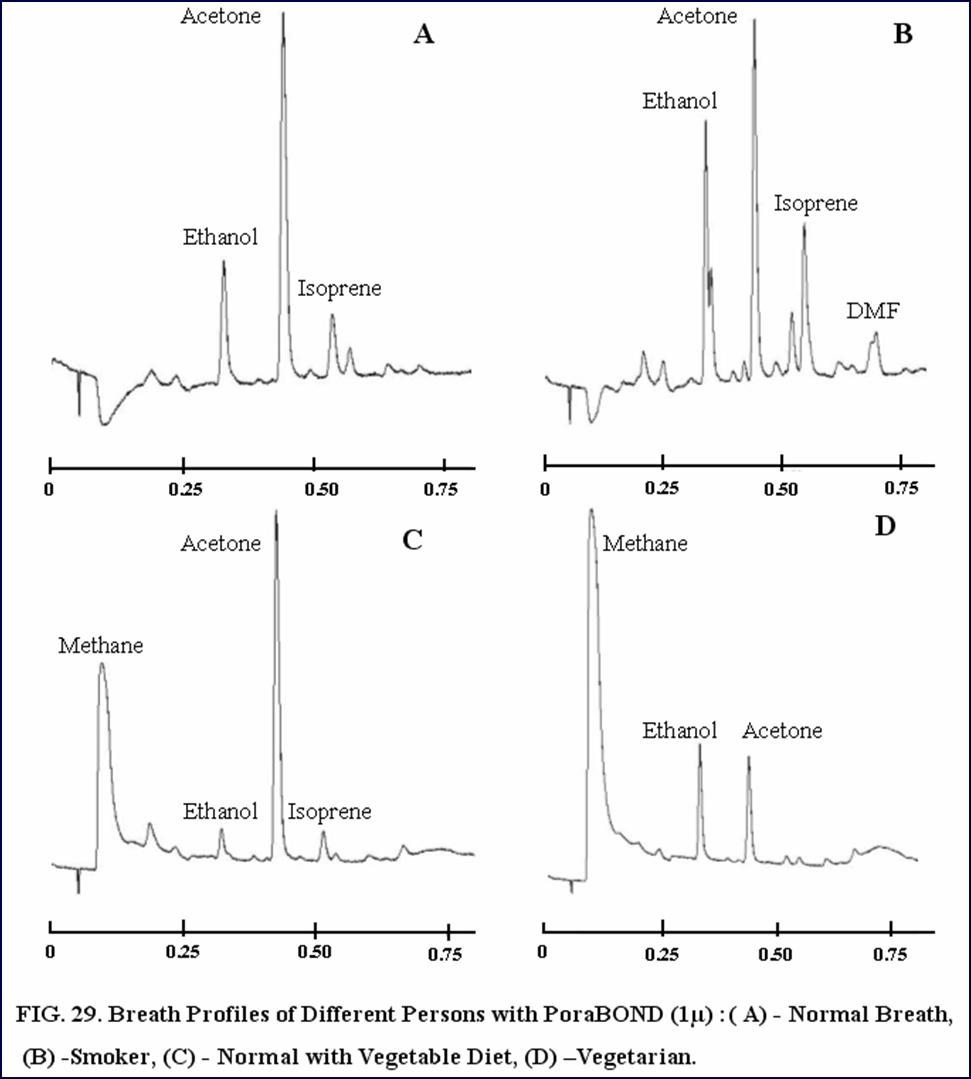Human Breath Analyzer for Medical Diagnostics
Aviv Amirav Gad Frishman and Nitzan Tzanani (July 2015)
Our GoalTo develop a new system for achieving fast, non invasive medical diagnostics, based on human breath analysis of trace levels of organic compounds. Such analysis with a small instrument having minimal or no maintenance could potentially become wide spread and significantly contribute to improved medical diagnostics.

Introduction
Exhaled human air contains volatile organic compounds at concentration levels that relate to their blood concentrations times their ambient vapor pressure. Approximately 200 compounds have been detected in human breath, some of which have been correlated to various diseases [1, 2]. Currently, laboratory based analysis of exhaled air is a complex, expensive and time consuming process and thus is not in wide spread use [1,2]. This situation could potentially change if such analysis of human breath could be performed at clinics and doctor rooms as a fast, low cost, easy to perform non-invasive procedure, for the potential diagnostics of a broad range of medical conditions and irregularities.

Our Novel Breath Analyzer
Our human breath analyzer is based on a new type of gas cylinder free gas chromatography system [3, 4]. This "GasFree" system is based on the use of a water electrolyzer as its only source of gases and is thus characterized by minimal maintenance and operation capability and compatibility at clinics and doctor rooms. An Electrolyzer powered Flame Ionization Detector (EFID) [5-7] serves as the GC detector for the sensitive, carbon selective detection of a broad range of volatile organic compounds. The concept of electrolyzer operated GC-EFID is based on the use of the electrolyzer produced oxygen and hydrogen gas mixture for consecutively sample desorption and sweeping in a purge and trap sampling system, as the analytical column carrier gas and as the only required EFID combustible gas mixture. We found, like others, that standard columns with polydimethylsiloxane adsorption film could be operated with oxygen up to 180-200C. A styrene-divinylbenzene based PoraBOND porous layer open tubular column was used for the GC separation of the organic human breath compounds, and we found that it could be operated up to 140ºC with the electrolyzer produced hydrogen and oxygen gas mixture. Our breath analysis system is characterized by the following desirable features.
 1. Fast Analysis.
Typical analysis time last less than one minute from breath sampling to the
results and readiness for next analysis.
1. Fast Analysis.
Typical analysis time last less than one minute from breath sampling to the
results and readiness for next analysis.
 2. Non Invasive Analysis.
Breath analysis is a non invasive medical diagnostics procedure.
2. Non Invasive Analysis.
Breath analysis is a non invasive medical diagnostics procedure.
 3. High Sensitivity System.
Our system enables sub 1 ppb detection limits.
3. High Sensitivity System.
Our system enables sub 1 ppb detection limits.
 4. Broad Range of Compounds are
Amenable for Analysis. All volatile organic compounds are amenable
for analysis with our system.
4. Broad Range of Compounds are
Amenable for Analysis. All volatile organic compounds are amenable
for analysis with our system.
 5. Small System with Minimal Maintenance.
The lack of gas cylinders makes the system maintenance simple, with only monthly
water replenishment.
5. Small System with Minimal Maintenance.
The lack of gas cylinders makes the system maintenance simple, with only monthly
water replenishment.
The combination of these features results in a system that could provide fast, non invasive, sensitive medical diagnostics, for a broad range of medical conditions and irregularities, at clinics and doctor rooms, with minimal size, cost and maintenance.
In the Figure below we demonstrate the applicability and compatibility of our system with the major requirements of exhaled human breath analysis. Exhaled air of four people indicated as A-D was sampled for 5 seconds at an air flow rate of 30 ml/min through a Teflon tube (1.6 mm OD, 0.8 mm ID, 20 cm length) that was connected to a check valve. The tube was positioned at the mouth of the volunteers and the exhaled air was analyzed in less than one minute as demonstrated. The relatively broad peak in traces C and D at around 8 seconds is assumed to be of methane and or ethane. The main peaks were identified as ethanol, acetone and isoprene (and dimethylfurane (DMF) for smokers). We have found a correlation between the observed amount of acetone and the person's type of diet. However, our analysis was qualitative and intended only at the demonstration of the capability of exhaled air analysis with the required sensitivity, in less than one minute and without any external gas source.


References
1. A. Manolis
The Diagnostic Potential of Breath Analysis.
Clin. Chem. 29, 5-15 (1983).
2. W-H Cheng and W-J Lee
Technology Development in Breath Microanalysis for Clinical Diagnosis.
J. Lab. Clin. Med. 133, 218-228 (1999).
3. A. Amirav, G. Frishman and N. Tzanani
A Method and System for Gas Chromatography
Israel and USA Patent Applications, Submitted on November 2000 (USA Patent
approved).
4. Gad Frishman, Nitzan Tzanani and Aviv Amirav
Electrolyzer Operated Gas Cylinder Free GC-FID
Field Analytical Chemistry and Technology 5, 107-115 (2001).
5. A. Amirav and N. Tzanani
Flame-Based Method and Apparatus for Analyzing a Sample.
a) Israel Patent No. 115287, Submitted on September 13, 1995.
b) USA Patent No 5741711 (1998).
c) Great Britain, Germany, France, Italy and The Netherlands, European
Patent 0763733.
d) Japan Patent Application 1996
6. A. Amirav and N. Tzanani
Electrolyzer Device and Method for the Operation of Flame Ionization
Detectors.
USA Patent No 6096178, Issued August 2000.
7. Nitzan Tzanani and Aviv Amirav
Electrolyzer Powered Flame Ionization Detector
Analytical Chemistry 69, 1248-1255 (1997).

Our Breath Analysis System Prototype is available for demonstrations and a collaboration with the industry is being looked for.
Reprints of reference 4 describing
our GasFree GC are available on request via Email.
For further information, please
contact me through my E-mail:
amirav@tau.ac.il